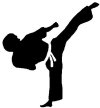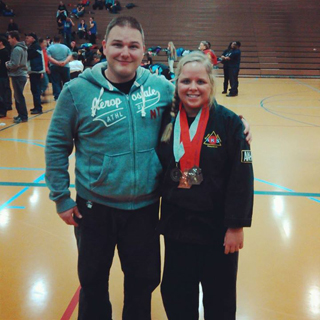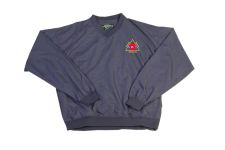
|

|
|
Online Edition: 043 March 2014 |
The Master's Edge 
Michael A. Sullenger
9th Dan AKS Chief Instructor . . . |
|
||||||||||||||||||||||||||||||||||||||||||||||||||||||||||||||||||||||||||||||||||||||||||||||||||||||||||||||||||||||||||||||||||||||||||||||||||||||||||||||||||||||||||||||||||||||||||||||||||||||||||||||||||||||||

Dave Thomas
8th Dan AKS Assistant Chief Instructor . . . |
When Will I Be Too Old?Frequently, I get surprised looks from new adult students or kid's parents when they visit class and I tell them that I have been in karate for 43 years. Occasionally, I share that I started when I was 20, I can see them quickly 'doing the math.' They are too polite to say after so many years I should consider hanging up my belt, but several have asked, "What keeps you teaching karate?" A fair question. When I began my martial arts career, I wanted to learn all I could. I loved the time spent with Instructors and fellow students learning new forms, sharpening my techniques. Among the students, we were always trying to kick higher or punch faster than our peers. The time spent on the floor at Muskegon Community College was exciting and memorable in many aspects. Those days will always be cherished memories. Certainly, I am beyond the competition years. At the time, competing was an affirmation of skill and ability if I won, the trophies were instant gratification. If I didn't do well, it was a lesson pointing where to improve, and nurtured the resolve to work harder. One of the last times I competed, Mr. Lieb asked me, "Why are you still competing, what do you have to prove?" I stopped signing up for tournaments at 57. In teaching, I am extremely fortunate to work with a group of Black Belts that are talented and hard working. They share my vision for teaching our students with energy and compassion. We strive to offer all our students the opportunity to learn and grow as we have. There have been times when I have not been at class, and the teaching goes on seamlessly. The students always give great reports of what they learned under the direction of these talented men and women. So why keep going? When Father Jim Wyse was training at Ross Park, we would often have great discussions in the parking lot after class. Our talks were as wide and varied as our respective interests. I have to admit, he knows more about the history of Spiderman than I ever will. One night after class, I was feeling tired and sore (I think I was about 55 then) and I said to him that I wasn't sure how much longer I could keep teaching karate. Fr. Wyse replied, "Gichin Funakoshi taught until he was 86." "Oh heck, (remember he's a priest), I guess I have another 30 years to go," I laughed. So what is it that keeps me going to class? Very simply it's the same drive, the same passion that keeps our Black Belts in West Virginia, Ohio, Texas as well as Michigan on the floor in front of their students. We are making a difference in the lives of our students. Long ago, karate became much less about us and much more about them. We do what we do for our students. Teaching them that they can learn to do things they had only dreamed of. Teaching them how to handle the bullies; how to live without fear. Not just children, but adults who want to learn a better way. I met a man close to 70 years old when he decided to join our class. A few months earlier, he had been diagnosed with Multiple Sclerosis. He started class expecting the exercise and movement would help forestall the debilitating effects of this crippling disease. He worked with us for over a year until his loss of balance threatened possible injury. He earned my respect and my admiration for giving his best effort in every class. When he was in class, he was positive and enthusiastic in his participation. He embodied the warrior spirit with grace and dignity; fighting a battle that others would never engage when faced with the same prognosis. Last week a mother told me her son was starting karate. He is a sweet and charming 8-year-old little boy with a kind heart and a gentle spirit. She said, though he wouldn't tell her who, she is convinced he is being bullied in school. He is embarrassed about his inability to deal with the thugs, but doesn't want adult intervention. So he now begins the journey, learning the techniques, working hard to make improvements, all the while making friends and being accepted for who he is. And like so many that have gone before him, he will grow in confidence, develop self-discipline and with time learn to like himself better. Watching this growth and enlightenment is what keeps me and so many others going to class; for that 8-year-old little boy and for so many others that can benefit from what we in American Karate have to offer. As Instructors, we will do for him what others have done for us. And we can feel good about making a difference in the lives of our students.
Actually, many of you know that 8-year-old boy. He is Christian Michael Thomas, my son. And I will continue to teach him and his classmates as long as I can make a positive tangible difference in their lives. Because they certainly make a tremendous difference in mine.
|
||||||||||||||||||||||||||||||||||||||||||||||||||||||||||||||||||||||||||||||||||||||||||||||||||||||||||||||||||||||||||||||||||||||||||||||||||||||||||||||||||||||||||||||||||||||||||||||||||||||||||||||||||||||||

Frederic A. Reinecke
8th Dan AKS Assistant Chief Instructor . . . |
Techniques for Free SparringAs a karate practitioner for 41 years, I have participated in over 100 tournaments. As a competitor you will try many techniques. Every person is different, so not all techniques work the same. I write this only to share my experiences knowing that I have had some success with these techniques. In sharing this, my hope is the reader will find some useful technique to enhance their own fighting skills. Carrying your guard. I watch many fighters simply bring their hands up to a guarded position, yet not have an effective guard. Your guard starts with your fighting stance. While there are several stances, the side stance and American fighting stance (45 degree angle), are the best to start with. Both of these stances allow you to protect your legs, groin, mid/upper torso and head. Your lead hand (closest to opponent), should be pointed at your opponents face. Your arm should be at a 45 degree bend at the elbow. Your elbow should be about a hands width away from your rib cage. This will then be an obstacle for your opponent to get past when he attacks. A straight jab can be an effective deterrent. The back hand/arm should be stationed across the middle of your chest. Moving up to the head, or down to the groin as needed. If you switch from stance to stance, always try and keep your guard centered and between you and your opponent. Try not to let your guard get wider than your shoulders. As you practice various techniques, learn to throw everything from this position; never telegraphing your technique to your opponent. This is just a starting point as there are many variations of a good guard. Lead Leg Attacks. Many of our strongest techniques come off the rear hand, such as the reverse punch, rear leg round kick. Although they are powerful, they also are easily seen by your opponent. An efficient fighter learns to lead with the closest hand or foot. This gives you several choices depending on how skilled your kicking or punching techniques are. This also speeds up the attack; simply because there is less distance to cover. Along with the actual technique, there are several steps that help you close the distance with your opponent.
Lead Hand Attacks. The back fist and lead hand jab are solid technique to use with this kind of movement.
While there are many other variations along this theme, this will be a good starting point. In the future, I am hoping to add photographs to illustrate these techniques. Until then, practice these until you can move without thought. If you have any questions, feel free to contact me.
Do You Have a Question ?We invite you to send in your questions regarding karate and the A.K.S. so that we may respond here in our newsletter. If you have a concern, question or suggestion, please let us know and we will address it here in the Punchline. If you don't want your name published, please let us know and we will be happy to withhold that information from print. However, please be respectful when submitting your queries or suggestions to us by including your name so that we may understand your questions and/or circumstances. We look forward to hearing from you !
|
||||||||||||||||||||||||||||||||||||||||||||||||||||||||||||||||||||||||||||||||||||||||||||||||||||||||||||||||||||||||||||||||||||||||||||||||||||||||||||||||||||||||||||||||||||||||||||||||||||||||||||||||||||||||

. . . |
PROMOTIONS!!
|
Congratulations to all students who have been promoted this past quarter, and to those we've missed in prior newsletters. Best wishes in your continued training! Attention Instructors, if you have students who have been promoted, please send this information so that we may acknowledge their accomplishments.
|

Michael A. Sullenger
9th Dan AKS Chief Instructor . . .
|
How Does Your Ego Compare to Your Legacy?Over the past couple of decades, as I've gotten older and have begun paying more attention to my life's accomplishments. I've not done this to say that I'm any better or worse than others, merely to examine how I will be remembered once the last date of my life is added; after the "dash" between my birth and death. This is not only what I've experienced in over five decades of martial arts studies and training, but in my military, law enforcement and teaching (both academic and martial arts) careers. Those reading this article who are in their 50's or older may be better able to appreciate where I'm going here. During a recent week-long course I attended at the Law Enforcement Management Institute (LEMIT) for new Chiefs of Police, one of our instructors shared a poem entitled, "The Dash" by Linda Ellis. You may read this poem at http://www.thedashpoem.com/. I encourage you to do so and to ponder how this would play out in your own life. Ms. Ellis points out that the dash represents how we spent our life; how we loved and lived during those years in between our birth and death dates. It asks us to consider slowing down and being less harsh or rash in our daily dealings with family and friends. And it points out that our life shouldn't be about what we were worth (money and property) in the end. So what does this have to do with those of us in the martial arts or any other lifelong endeavor we've chosen? Clearly anyone who has spent any time training and competing in karate will immediately appreciate the number of competitors whose ego preceded them into the room. They saw themselves as larger than life and better than anyone else there. The purpose for them competing nearly every month at some tournament around the country was to continually challenge this hypothesis, which also fueled their growing ego. In my experience, many of these people maintained this attitude into later years when they were clearly no longer able to keep up with the youngsters. At some point down the road, we begin to realize we've gotten older. We're not as fast or as strong as we once were. We are no longer able to compete with the younger competitors rising in the ranks. For some, this resulted in the "mid-life" crisis. They begin doing things they feel will help them recapture their youth. Other more pragmatic folk merely accepted the fact that it is the natural part of the life cycle and adjusted. A few years ago, I began to realize the impact I was having on the lives of those I was teaching, both in the dojo, the academic classroom, and the police cadets in the local academy. This new awareness was the result of feedback from former students, and in some cases their parents. It also came in the explanation I received from Hanshi Dan Hect, CEO of the Masters Hall of Fame after receiving a letter of nomination in the Spring of 2008. With this new awakening, I wrote an article entitled, "The Importance of Mentoring." Clearly one must, at some point in their life, become aware of the impact they have had and continue to have on others. Has it been a positive or negative one? Only the recipients can answer that question. If you are blessed enough to have received feedback, then you know the answer. If not, are you aware of how you have impacted the lives of others? I've come to grips with the fact I can't keep up with the younger generations. Without a doubt, there are those who have a great deal of difficulty accepting this realization. My goal in my latter years is to share what I've learned over these decades in an effort to help younger students gain from my experiences and the wisdom that has resulted from them. It is clear many people are not capable of making the transition. This is evident by their comments and attitudes. The way they conduct themselves around others, as if they were still in their thirties, is telling. From a martial arts stand point, what does this say about the failure of their sensei to impart this knowledge to them? Anyone who has read Funakoshi's autobiography, "Karate Do, My Way of Life," is keenly aware of the importance of humility and leading by example. In the end, it comes down to the "dash." How did we live our lives? How did we learn from our mistakes? Did the learning curve from those mistakes benefit us or not? When we are no longer among the living, what will those left behind have to say about how we spent our "Dash."
Michael A. Sullenger 9th Dan We thank those who have contributed articles to our newsletter. We encourage anyone who would like to contribute to this "quarterly" space to submit your article to: werner.lj@gmail.com
|

. . .
|
| |||||||||||||||||||||||||||||||||||||||||||||||||||||||||||||||||||||||||||||||||||||||||||||||||||||||||||||||||||||||||||||||||||||||||||||||||||||||||||||||||||||||||||||||||||||||||||||||||||||||||||||||||||






